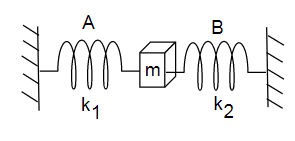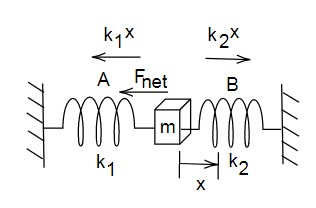
In the arrangement given in figure, if the block of mass m is displaced, the frequency is given by

A. \[n = \dfrac{1}{{2\pi }}\sqrt {\left( {\dfrac{{{k_1} - {k_2}}}{m}} \right)} \]
B. \[n = \dfrac{1}{{2\pi }}\sqrt {\left( {\dfrac{{{k_1} + {k_2}}}{m}} \right)} \]
C. \[n = \dfrac{1}{{2\pi }}\sqrt {\left( {\dfrac{m}{{{k_1} + {k_2}}}} \right)} \]
D. \[n = \dfrac{1}{{2\pi }}\sqrt {\left( {\dfrac{m}{{{k_1} - {k_2}}}} \right)} \]
Answer
216.3k+ views
Hint: To find the frequency consider the small displacement of the block by x and find the net force acting on the block in terms of their springs constant.
Formula used:
\[T = \dfrac{{2\pi }}{\omega },\,n = \dfrac{1}{T}\] and \[\omega = \sqrt {\dfrac{k}{m}} \]
Where, T= Time period of oscillation,\[\omega \] = Angular frequency of oscillation, n = Frequency of oscillation, k= Spring constant and m = Mass suspended to spring
Complete step by step solution:
Given here is a spring block system of two springs A and B of constant \[{k_1}\] and \[{k_2}\]respectively, we have to find the frequency when block m is displaced from its position.
Let the block m be displaced by x towards the right then spring A will pull the block by force \[{k_1}x\] and compression force acting on spring B will be \[{k_2}x\] as shown in the image below,

Image: Force on the spring block system
Then, the net force acting on the block will be
\[{F_{net}} = {k_1}x + {k_2}x \Rightarrow {F_{net}} = - \left( {{k_1} + {k_2}} \right)x\,.......(1)\]
Negative magnitude on the net force in \[{F_{net}} = - \left( {{k_1} + {k_2}} \right)x\] signifies the opposite direction of net force with respect to displacement.
From F= ma, acceleration a of the block can be expressed as,
\[a = \dfrac{{{F_{net}}}}{m} \Rightarrow a = \dfrac{{ - \left( {{k_1} + {k_2}} \right)x}}{m}\,........(2)\]
Comparing equation (2) with we get,
\[{\omega ^2} = \dfrac{{{k_1} + {k_2}}}{m} \Rightarrow \omega = \sqrt {\dfrac{{{k_1} + {k_2}}}{m}} \,.........(3)\]
Then, the frequency of oscillation is given by,
\[n = \dfrac{1}{T} = \dfrac{\omega }{{2\pi }}\,........(4)\]
Substituting the value of from equation (3) in equation (4) frequency will be,
\[n = \dfrac{1}{{2\pi }}\sqrt {\dfrac{{{k_1} + {k_2}}}{m}} \,\]
Therefore, option B is the correct option.
Note: If the acceleration of an oscillating body is of the form \[a = - {\omega ^2}x\], then the body is said to be performing simple harmonic motion (S.H.M.)
Formula used:
\[T = \dfrac{{2\pi }}{\omega },\,n = \dfrac{1}{T}\] and \[\omega = \sqrt {\dfrac{k}{m}} \]
Where, T= Time period of oscillation,\[\omega \] = Angular frequency of oscillation, n = Frequency of oscillation, k= Spring constant and m = Mass suspended to spring
Complete step by step solution:
Given here is a spring block system of two springs A and B of constant \[{k_1}\] and \[{k_2}\]respectively, we have to find the frequency when block m is displaced from its position.
Let the block m be displaced by x towards the right then spring A will pull the block by force \[{k_1}x\] and compression force acting on spring B will be \[{k_2}x\] as shown in the image below,

Image: Force on the spring block system
Then, the net force acting on the block will be
\[{F_{net}} = {k_1}x + {k_2}x \Rightarrow {F_{net}} = - \left( {{k_1} + {k_2}} \right)x\,.......(1)\]
Negative magnitude on the net force in \[{F_{net}} = - \left( {{k_1} + {k_2}} \right)x\] signifies the opposite direction of net force with respect to displacement.
From F= ma, acceleration a of the block can be expressed as,
\[a = \dfrac{{{F_{net}}}}{m} \Rightarrow a = \dfrac{{ - \left( {{k_1} + {k_2}} \right)x}}{m}\,........(2)\]
Comparing equation (2) with we get,
\[{\omega ^2} = \dfrac{{{k_1} + {k_2}}}{m} \Rightarrow \omega = \sqrt {\dfrac{{{k_1} + {k_2}}}{m}} \,.........(3)\]
Then, the frequency of oscillation is given by,
\[n = \dfrac{1}{T} = \dfrac{\omega }{{2\pi }}\,........(4)\]
Substituting the value of from equation (3) in equation (4) frequency will be,
\[n = \dfrac{1}{{2\pi }}\sqrt {\dfrac{{{k_1} + {k_2}}}{m}} \,\]
Therefore, option B is the correct option.
Note: If the acceleration of an oscillating body is of the form \[a = - {\omega ^2}x\], then the body is said to be performing simple harmonic motion (S.H.M.)
Recently Updated Pages
JEE Atomic Structure and Chemical Bonding important Concepts and Tips

JEE Amino Acids and Peptides Important Concepts and Tips for Exam Preparation

Electricity and Magnetism Explained: Key Concepts & Applications

Chemical Properties of Hydrogen - Important Concepts for JEE Exam Preparation

JEE Energetics Important Concepts and Tips for Exam Preparation

JEE Isolation, Preparation and Properties of Non-metals Important Concepts and Tips for Exam Preparation

Trending doubts
JEE Main 2026: Application Form Open, Exam Dates, Syllabus, Eligibility & Question Papers

Derivation of Equation of Trajectory Explained for Students

Hybridisation in Chemistry – Concept, Types & Applications

Understanding the Angle of Deviation in a Prism

Understanding Collisions: Types and Examples for Students

How to Convert a Galvanometer into an Ammeter or Voltmeter

Other Pages
JEE Advanced Marks vs Ranks 2025: Understanding Category-wise Qualifying Marks and Previous Year Cut-offs

Units And Measurements Class 11 Physics Chapter 1 CBSE Notes - 2025-26

NCERT Solutions For Class 11 Physics Chapter 8 Mechanical Properties Of Solids

Motion in a Straight Line Class 11 Physics Chapter 2 CBSE Notes - 2025-26

NCERT Solutions for Class 11 Physics Chapter 7 Gravitation 2025-26

Ideal and Non-Ideal Solutions Explained for Class 12 Chemistry




